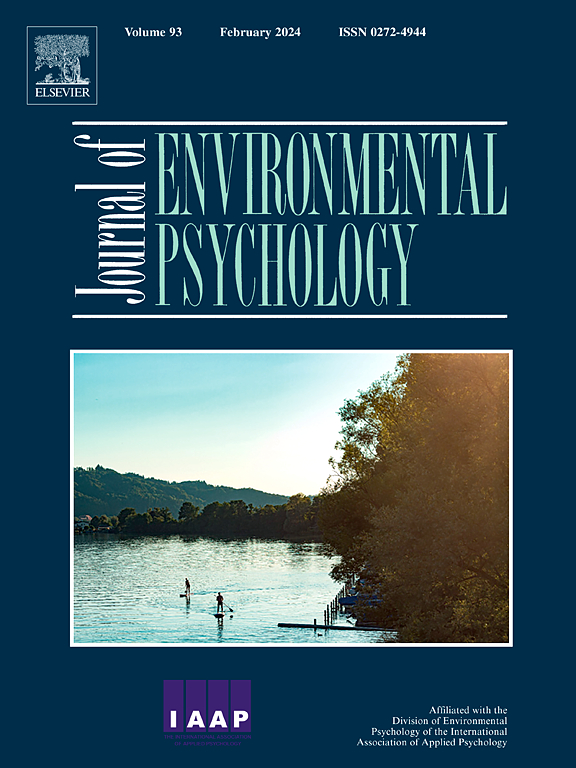Compassion questionnaire for animals: Scale development and validation
IF 6.1
1区 心理学
Q1 ENVIRONMENTAL STUDIES
引用次数: 0
Abstract
Objectives
No measure of compassion for animals exists. Previous scales measured empathy or attitudes towards animals. In line with previous compassion questionnaires for self (CQS) and others (CQO), the proposed Compassion Questionnaire for Animals (CQA) aims to operationalize compassion for animals by grounding it in affective, cognitive, behavioral, and interrelatedness dimensions, each representing a set of skills that can be cultivated through training and practice.
Methods
Based on the proposed theoretical approach, the CQA items were developed through consultations with a panel of eight graduate students. A large study was conducted to validate the CQA, investigate the relationship between empathy/compassion for other human beings and compassion for animals, and test the role of gender and age in compassion for animals.
Results
Results suggested the presence of three dimensions along with a global latent variable. Psychometric characteristics of the CQA and its subscales were robust. These findings were additionally supported by convergent and discriminate evidence; as such, the CQA presented strong associations with measures of empathy for animals and nature relatedness. In addition, empathy and compassion for other human beings and for animals were found to be moderately associated. Gender and age were found to be related to compassion for animals, with women and older individuals displaying higher levels of compassion.
Conclusions
The CQA is the first scale that operationalizes compassion for animals as a set of affective, cognitive, behavioral, and interrelatedness skills/abilities with important theoretical and practical implications. Limitations as well as theoretical and practical implications of the CQA are thoroughly discussed.
关爱动物问卷:量表开发与验证
目标目前还没有衡量对动物同情心的量表。以前的量表测量的是对动物的同情或态度。与之前的自我同情心问卷(CQS)和他人同情心问卷(CQO)相一致,拟议的动物同情心问卷(CQA)旨在通过将对动物的同情心建立在情感、认知、行为和相互关联维度的基础上,使其具有可操作性,每个维度都代表了一套可以通过训练和实践来培养的技能。我们进行了一项大型研究,以验证 CQA,调查对他人的同情/怜悯与对动物的怜悯之间的关系,并测试性别和年龄在对动物的怜悯中的作用。结果结果表明,CQA 存在三个维度和一个总体潜变量。CQA 及其子量表的心理计量学特征稳健。此外,这些结果还得到了收敛性和区分性证据的支持;因此,CQA 与对动物的同情心和自然亲和力的测量结果具有很强的关联性。此外,对其他人和动物的同理心和同情心也有中度关联。结论CQA是第一个将对动物的同情心作为一套情感、认知、行为和相互关联的技能/能力来操作的量表,具有重要的理论和实践意义。本文对 CQA 的局限性以及理论和实践意义进行了深入讨论。
本文章由计算机程序翻译,如有差异,请以英文原文为准。
求助全文
约1分钟内获得全文
求助全文
来源期刊

Journal of Environmental Psychology
Multiple-
CiteScore
10.60
自引率
8.70%
发文量
140
审稿时长
62 days
期刊介绍:
The Journal of Environmental Psychology is the premier journal in the field, serving individuals in a wide range of disciplines who have an interest in the scientific study of the transactions and interrelationships between people and their surroundings (including built, social, natural and virtual environments, the use and abuse of nature and natural resources, and sustainability-related behavior). The journal publishes internationally contributed empirical studies and reviews of research on these topics that advance new insights. As an important forum for the field, the journal publishes some of the most influential papers in the discipline that reflect the scientific development of environmental psychology. Contributions on theoretical, methodological, and practical aspects of all human-environment interactions are welcome, along with innovative or interdisciplinary approaches that have a psychological emphasis. Research areas include: •Psychological and behavioral aspects of people and nature •Cognitive mapping, spatial cognition and wayfinding •Ecological consequences of human actions •Theories of place, place attachment, and place identity •Environmental risks and hazards: perception, behavior, and management •Perception and evaluation of buildings and natural landscapes •Effects of physical and natural settings on human cognition and health •Theories of proenvironmental behavior, norms, attitudes, and personality •Psychology of sustainability and climate change •Psychological aspects of resource management and crises •Social use of space: crowding, privacy, territoriality, personal space •Design of, and experiences related to, the physical aspects of workplaces, schools, residences, public buildings and public space
 求助内容:
求助内容: 应助结果提醒方式:
应助结果提醒方式:


